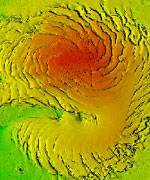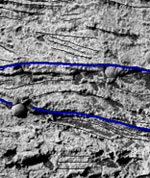
Image credit: Hubble
WIMPs speeding at 670,000 mph on a “highway” in space may be raining onto Earth ? a phenomenon that might prove the existence of “dark matter” that makes up most our galaxy and one-fourth of the universe, says a study co-authored by a University of Utah physicist.
Many researchers have long suspected that dark matter may be made of WIMPS or Weakly Interacting Massive Particles, which are theorized subatomic particles. More than 20 groups of physicists worldwide are building or have built devices to detect them.
Scientists who run a WIMP detector named DAMA (Dark Matter) in Italy claimed in 1998 that the underground device sensed WIMPs reaching Earth from an unseen halo of dark matter surrounding our Milky Way galaxy. The claim was doubted by scientists who run other WIMP detectors, which are designed differently than DAMA and have not found WIMPs.
The new study ? published in the March 19 issue of the journal Physical Review Letters ? advises how the DAMA scientists might prove their claim.
“We?re suggesting a way to check if what DAMA claimed to have seen are really WIMPs,” says study co-author Paolo Gondolo, an assistant professor of physics at the University of Utah. “This is about finding out what 90 percent of our galaxy is made of.”
Gondolo and colleagues say that in addition to the WIMPs pouring into our Milky Way galaxy from the surrounding halo, a dark matter “highway” of WIMPS may be raining onto our solar system after flying out of Sagittarius, a dwarf galaxy that slowly is being gobbled up and torn apart by gravity from the Milky Way.
The combination of the Milky Way WIMPS and those from the Sagittarius dwarf galaxy should produce a distinct pattern in the Italian data that “would be a smoking gun for WIMP detection,” the new study says.
Gondolo conducted the research with physicist Katherine Freese and graduate student Matthew Lewis of the University of Michigan, and astronomer Heidi Jo Newberg of Rensselaer Polytechnic Institute in Troy, N.Y.
The Dark Side of the Universe
Scientists realized a few decades ago that the motions of galaxies within the universe could not be explained by the gravitational pull of visible galaxies, stars and gases. For a long time, scientists said that 10 percent of the universe was visible matter and 90 percent was unseen dark matter filling the voids among stars and galaxies.
In recent years, however, astronomers determined that the universe and its galaxies were flying apart at an accelerating rate, a phenomenon consistent with the existence of an anti-gravitational force known as “dark energy.”
Gondolo says scientists now believe the universe is about 5 percent visible matter, 25 percent dark matter and 70 percent dark energy.
Unlike dark matter, which is subject to gravity, dark energy is not pulled into our galaxy, so the Milky Way is about 10 percent matter and 90 percent dark matter, Gondolo says.
The spinning motion of the flattened, spiral disk-shaped Milky Way is too fast to be explained merely by the gravity of its visible stars and gases, so scientists believe it is surrounded by a much larger “halo” ? actually a flattened sphere ? that contains some stars but mostly unseen dark matter.
Over the years, numerous theories were proposed as to the nature of the dark matter: from dim brown dwarf stars that never ignited to the whimsically named MACHOs (Massive Compact Halo Objects) and subatomic WIMPs.
Gondolo says WIMPs and other subatomic particles called axions now are considered the most likely candidates to be dark matter.
The DAMA detector, located at Italy?s Gran Sasso National Laboratory, is run by an international collaboration of physicists led by the University of Rome. The DAMA group announced in 1998 that it found evidence for WIMPS.
Because DAMA is underground, overlying rock filters out particles created when cosmic rays hit Earth?s atmosphere and produce showers of smaller particles. WIMPs are “weakly interacting” particles, so they pass through Earth. But they can hit sodium iodide crystals inside DAMA, causing flashes of light and making sodium or iodine ions recoil.
If WIMPs do exist, they flow toward our solar system from the halo around our galaxy. As the Earth orbits around the sun, it sometimes moves “upstream” against the flow of oncoming WIMPs, and sometimes moves with the flow. The DAMA scientists believe this explains the up-and-down pattern in the number of particles detected by DAMA, and supports the assertion those particles are WIMPs.
Other physicists, however, remain unconvinced. Their detectors, which use germanium as a sensor instead of sodium iodide, should be equally sensitive, but have not “seen” WIMPs. They argue the annual fluctuation in the number of particles detected by DAMA may be caused by seasonal changes in the atmosphere, the DAMA detector or DAMA?s environment, so that the particles have not been proven to be WIMPs.
The New Study: A Solution from Sagittarius?
The visible Milky Way is vast, about 100,000 light years across, or about 588 million billion miles (588 times 10 to the 15th power). For eons, the Milky Way has been absorbing and tearing apart the Sagittarius dwarf galaxy, which is one-tenth the Milky Way?s diameter.
Newberg and other astronomers recently discovered two arc-shaped “tails” or streams of stars flowing from Sagittarius. The streams are believed to also contain WIMPs ? if they exist. Our solar system sits in one of these streams, which Gondolo and Freese describe as a possible “dark matter ?highway? raining down upon the solar system.”
In the new study, Gondolo and colleagues suggest how the combination of WIMPs from the Milky Way?s halo and from the Sagittarius stream would register on the DAMA detector:
— The dates of the maximum and minimum number of WIMPs detected by DAMA would shift when dark matter from Sagittarius is considered. That is because the Sagittarius WIMPs hit Earth from a different angle than Milky Way halo WIMPS, changing the dates when the most and the fewest WIMPs hit Earth and thus DAMA. Gondolo says the peak should be May 25 instead of June 2 if Sagittarius WIMPs and halo WIMPs both hit Earth. DAMA found the maximum was
May 21, plus or minus 22 days.
— The “smoking gun” that would prove WIMPS exist is more complicated to explain. When particles hit sodium iodide in DAMA, the ions recoil in proportion to the mass and speed of the incoming particle. Gondolo says WIMPs from the Milky Way halo move at speeds of zero to 600 kilometers per second (1.34 million mph), with an average speed of 220 kilometers per second (about 492,000 mph). WIMPs in the Sagittarius stream or highway all move at 300 kilometers per second (about 671,000 mph). When the recoil energies of the two kinds of WIMPs are combined and plotted on a graph, there should be a steep “step” or drop in the number of collisions with higher recoil energies, reflecting the fact that Sagittarius WIMPs do not exceed 671,000 mph.
If DAMA scientists find that “step” in their data, it should be the smoking gun to prove dark matter exists in the form of WIMPs, Gondolo says.
“This would be a corroboration of their result,” he adds. “As way to check if they really have seen WIMPs, they could look for the specific signature of WIMPs in the Sagittarius stream.”
Scientists at DAMA are aware of the new study and are rechecking their data to determine if it contains the evidence that could prove the detector found WIMPs. The process could take months, and it will take a few years for newer detectors to confirm the finding, Gondolo says.
He and his colleagues suspect other detectors have not found WIMPs because the particles may be lighter and smaller than expected, so germanium does not recoil much when hit by an incoming WIMP, while DAMA?s ions have measurable recoil.
Gondolo says he studies dark matter because “I want to know what the universe is made of. I was unsatisfied when I learned most of the universe is not made of atoms.”
Original Source: University of Utah News Release








